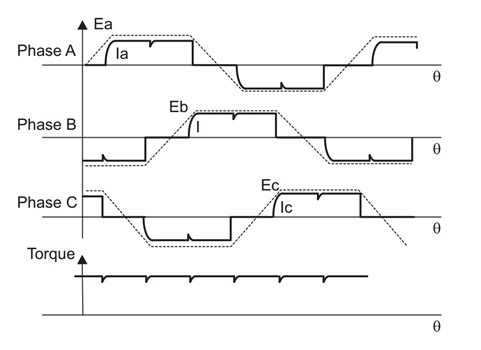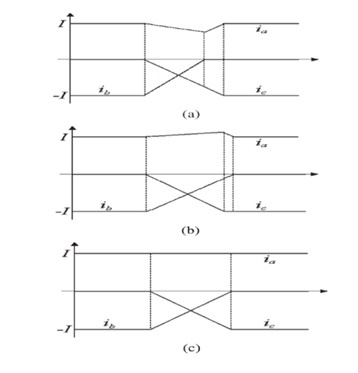SSZTBM0 february 2016
When consumers buy appliances, a few key factors influencing their decision include star rating or energy efficiency, acoustic noise level and an attractive user interface. What causes acoustic noise? Major home appliances like washing machines, refrigerators, air conditioners and range hoods use motors to operate. Acoustic noise is created when the motor’s torque ripple, combined with the appliance enclosure or structure, causes vibration. So, one of the important areas of research and development for appliance manufacturers is how to reduce acoustic noise.
In part 1 of this series, I’ll provide an overview of various sources of torque ripple in brushless direct current (BLDC)- and permanent magnet synchronous motor (PMSM)-based systems and its impact on acoustic noise level.
Torque Ripple
The gross output torque from BLDC motors and PMSMs is the sum of beneficial electromagnetic torque (steady torque) and unwanted torque or torque ripple produced by commutation, DC bus ripple, cogging torque and friction.
You can use Equation 1 to calculate torque ripple:
where Tav, Tmax and Tmin are the average, maximum and minimum torque over one mechanical revolution, respectively.
Commutation /Electromagnetic Torque Ripple in BLDC Motors
Equation 2 calculates torque for three-phase permanent magnet motors:
where Te is the electromagnetic torque generated; Ea, Eb and Ec are the back electro motive force of the phase windings; Ia, Ib and Ic are winding currents; and is the angular velocity (mechanical speed) of the rotor.
Because of concentrated winding, BLDC motors have near-trapezoidal-phase back-EMF waveforms and a six-step commutation method controls these motors. Figure 1 shows Ia, Ib and Ic with a six-step commutation method and the back-EMF waveforms (Ea, Eb and Ec) of a star-connected BLDC motor. If you assume an ideal square-current waveform applied to the winding, the torque generated will be constant without any ripple. However, in reality, winding currents cannot rise or fall instantaneously because of the winding inductance. This causes torque ripple during the commutation of BLDC motor phase currents as shown in Figure 1.
Figure 2 shows three different cases depending on the current’s rising and falling rate of the commutating windings. Assuming that the current increase and decrease rates of the two windings are the same as shown in Figure 2(c), the developed electromagnetic torque is constant. Figure 2(a) and Figure 2(b) show cases where there is a mismatch in the current’s rising and falling rate of the commutating windings, which in turn causes commutation torque ripple.
 Figure 1 Electrical Waveforms for a BLDC Motor in the Two-phase on Operation Method
Figure 1 Electrical Waveforms for a BLDC Motor in the Two-phase on Operation Method Figure 2 Winding Current Forms Causing Torque Ripple: Decreased Torque (a), Increased Torque (b) and Constant Torque (c)
Figure 2 Winding Current Forms Causing Torque Ripple: Decreased Torque (a), Increased Torque (b) and Constant Torque (c)Commutation / Electromagnetic Torque Ripple in PMSMs
PMSMs have sinusoidally distributed winding and thus sinusoidal back-EMF waveforms. As long as the current fed into the motor-phase winding is sinusoidal and in phase with the corresponding phase-winding back-EMF , the electromagnetic torque developed will be constant without any torque ripple. This is possible through field-oriented control (FOC), where individual, instantaneous winding-phase currents are measured and controlled to be sinusoidal. The accuracy of current sensing and current-loop bandwidth determines the quality of current-waveform and hence the torque developed. Sensing and control inaccuracies can introduce torque ripples.
Sinusoidal scalar control can also be useful for PMSMs. This method is less complex compared to FOC. Most single-chip motor controllers implement sinusoidal scalar control to help reduce torque ripple and acoustic noise.
A PMSM driven with six-step trapezoidal current control (as in BLDC motors) will result in torque ripple, as shown in Figure 3.
 Figure 3 Torque Ripple When a PMSM Is Driven as a BLDC Motor Using Six-step Commutation
Figure 3 Torque Ripple When a PMSM Is Driven as a BLDC Motor Using Six-step CommutationTorque Ripple Due to DC-bus Voltage Ripple in Mains-operated Motor Drives
Bulk electrolytic capacitors are used on the high-voltage DC bus link of a mains-operated BLDC and PMSM drive. The value of the capacitor for a given load decides the magnitude of ripple on the DC bus. In the motor control, if average DC bus voltage is used for PWM duty cycle computation, without considering instantaneous DC-bus voltage ripple, the DC-bus voltage ripple will result in winding-current distortion and thus torque ripple.
A simple way to minimize torque ripple caused by DC-bus voltage ripple is to use a very-high-value DC bus capacitor. This will increase overall size and system cost, as high-voltage capacitors are bulkier and take up a significant share of the bill of materials cost. A general thumb rule is to calculate the DC bus capacitor value to maintain DC-bus voltage ripple within 5-10%, depending on the quality of performance required. Another way to reduce the torque ripple caused by the DC-bus voltage ripple is through feed forward compensation implementation in the software. Through this method, you can reduce the capacitance value and cost and at the same time reduce the torque ripple. For this implementation, the instantaneous DC-bus voltage needs to be measured and used for PWM duty cycle update.
Figure 4 shows the winding current of a BLDC motor with a six-step commutation method. Figure 4(a) shows the waveform when the inverter drive is powered from a pure DC source with an undistorted current waveform. Figure 4(b) shows how the DC-bus voltage ripple on the mains-rectified DC bus link deteriorates the winding-current waveform without DC-bus ripple compensation. Figure 4(c) shows how the DC-bus ripple compensation in software helps maintain a proper winding-current waveform even with high DC-bus voltage ripple. These waveforms are taken from TI Design TIDA-00472. Refer to this design document for more details.
 Figure 4 BLDC Winding Current Waveforms: with DC Source (a), Mains Powered without DC-bus Compensation (b) and with DC-bus Compensation (c)
Figure 4 BLDC Winding Current Waveforms: with DC Source (a), Mains Powered without DC-bus Compensation (b) and with DC-bus Compensation (c)In part 2 of this series, I will discuss about cogging torque, which is another major source creating unwanted torque ripple.
Additional Resources
- Check out these reference designs:
- Read these IEEE articles: Torque ripple minimization in direct drive systems and Torque Ripple Reduction of BLDC Motors by Modifying the Non-Commutating Phase Voltage.